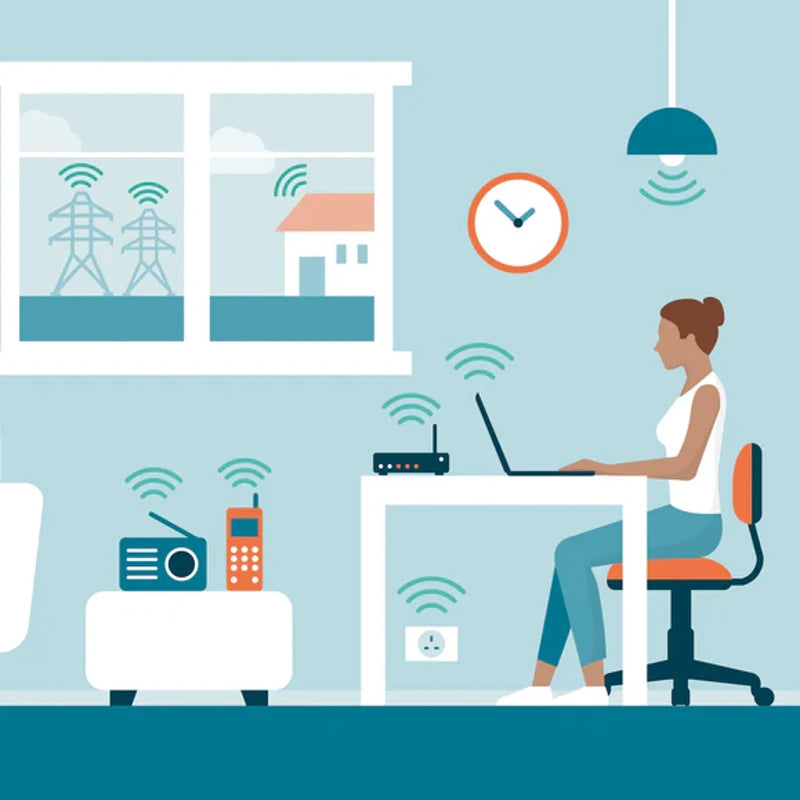With the increasing presence of electronic devices in our homes, EMF exposure (electromagnetic fields) has become a topic of interest for many. Everyday devices such as phones, WiFi routers, and even kitchen appliances emit EMF, and while these exposures are typically low, some individuals report experiencing emf sensitivity symptoms. This article will identify common sources of EMF at home and offer practical strategies to reduce EMF exposure, ensuring a safer environment.
Understanding EMF and Its Types
Electromagnetic fields, or EMF, are invisible energy waves emitted by electrical devices. There are two primary types of EMF: low-frequency (non-ionizing) and high-frequency (ionizing). Non-ionizing EMF is emitted by most household electronics, while ionizing EMF is typically associated with x-rays and certain industrial machinery.
Concerns about emf sensitivity symptoms arise for individuals who experience headaches, fatigue, or discomfort in environments with high EMF levels. Although research is ongoing, understanding these effects is vital to minimizing exposure where possible.
Common EMF Sources at Home
Cell Phones and Laptops
Cell phone radiation is a primary EMF source, especially since many of us carry our phones close to our bodies throughout the day. Laptops also emit EMF, particularly when resting on our laps, which can increase exposure.
To mitigate this, consider using a laptop emf shield to reduce EMF exposure, and when possible, keep your phone away from your body, particularly during sleep.
WiFi Routers and Smart Meters
Our reliance on wireless connectivity means that devices like WiFi routers and smart meters are often running 24/7, continuously emitting EMF. These devices may contribute to wifi health risks, particularly when they’re close to living spaces.
For a safer setup, position your WiFi router at a distance from bedrooms or communal areas, and use a timer to turn off the router at night if feasible. Be aware of smart meter risks as well, as these devices track energy usage but can increase household EMF.
Cordless Phones and Other Wireless Devices
Like cell phones, cordless phones emit EMF, sometimes at levels comparable to mobile devices. Other wireless devices, like Bluetooth speakers and wireless baby monitors, also contribute to overall EMF in the home.
If possible, opt for wired devices, and maintain an emf-safe distance from these devices, particularly during extended use.
Home Appliances (Microwaves, TVs, etc.)
Home appliances, including microwaves and televisions, emit low-level radiation while in operation. Although levels are generally low, frequent and prolonged exposure can contribute to household EMF.
Consider low-emf appliances for a safer alternative, and maintain distance from devices like microwaves while in use. TV radiation levels are also worth noting, as older models may emit more EMF than newer, energy-efficient designs.
Lighting and Electric Blankets
Certain lighting types, including fluorescent bulbs, emit EMF. Additionally, electric blankets generate EMF as they heat up, which can raise concerns for those sleeping with them.
Switching to low-emf appliances or opting for incandescent bulbs can help reduce exposure. Limiting electric blanket use or selecting low-EMF alternatives can further minimize EMF exposure while sleeping.
Power Lines and External Sources
While most household EMF originates from internal devices, power line radiation from nearby power lines or transformers can contribute to EMF levels within your home.
To address this, consider home emf testing to determine if external sources impact your home environment. An EMF meter can help you identify if additional protection is necessary.
Practical Tips for Minimizing EMF Exposure at Home
Reducing Exposure from Electronics
One of the best strategies for emf home protection is to limit your time around high-EMF devices. Simple practices like enabling airplane mode on phones when not needed and turning off devices when not in use can significantly reduce daily radiation exposure.
Using EMF-Blocking Products
EMF blocking curtains and shields can be useful in areas where you cannot reduce EMF from the source. For example, these materials can be placed near windows facing cell towers or power lines. EMF protection products like these help create low-EMF zones within your home, particularly in bedrooms.
Testing and Monitoring EMF Levels
Regularly monitoring your home with home emf testing tools can help you keep track of EMF levels and take appropriate action as needed. Home radiation testing allows you to detect high-EMF zones and adjust your living arrangement to maintain lower EMF exposure levels, providing peace of mind.
Creating Distance and Reducing Wireless Use
Maintaining an emf-safe distance from high-EMF devices is one of the simplest yet most effective ways to reduce exposure. Opting for wired connections rather than WiFi, particularly for devices in regular use, can lower EMF levels.
Creating “no-EMF” zones in the home, such as WiFi-free bedrooms, also helps in reducing EMF exposure over time.



Laisser un commentaire
Ce site est protégé par hCaptcha, et la Politique de confidentialité et les Conditions de service de hCaptcha s’appliquent.